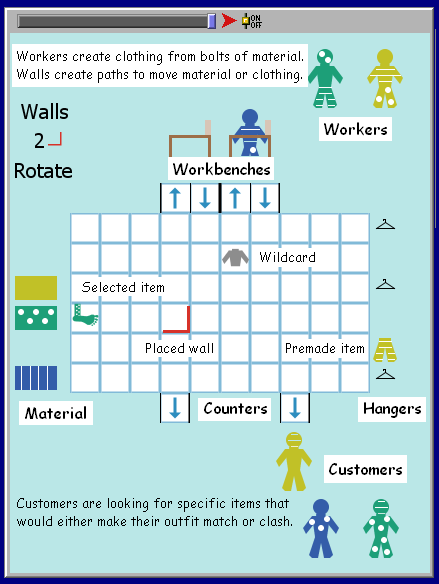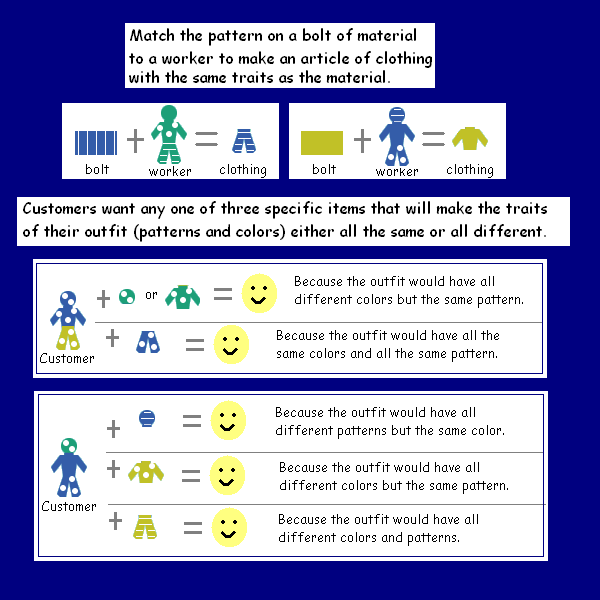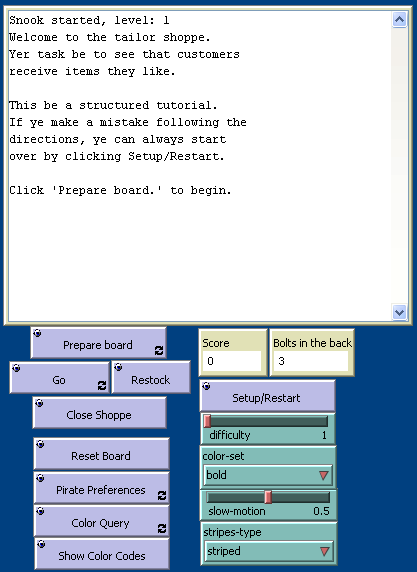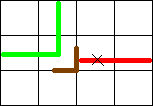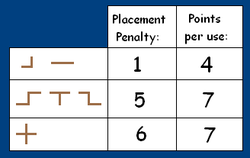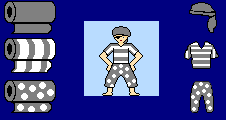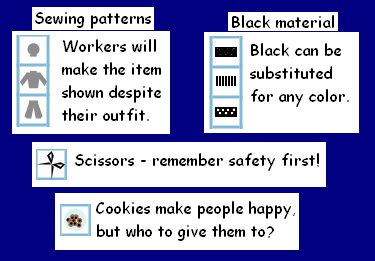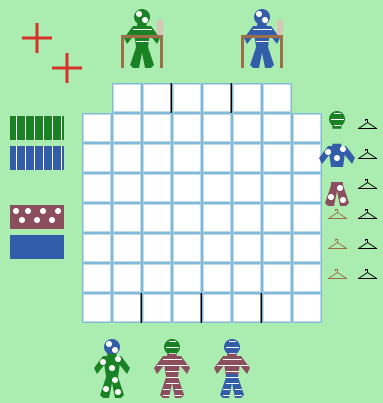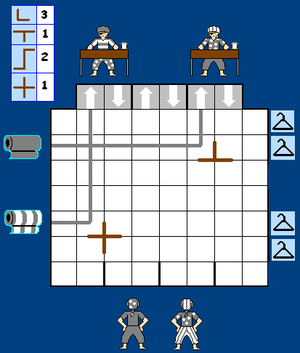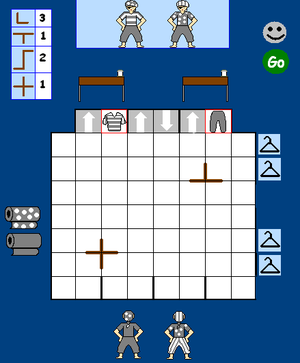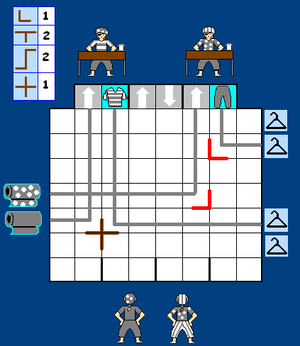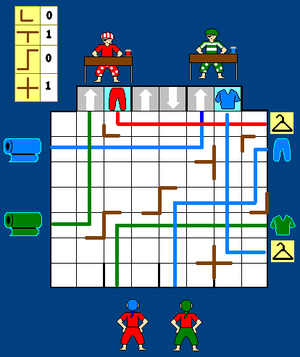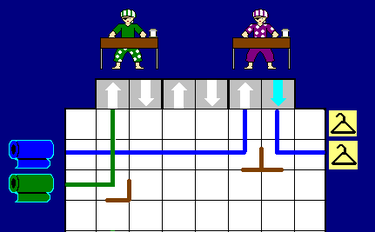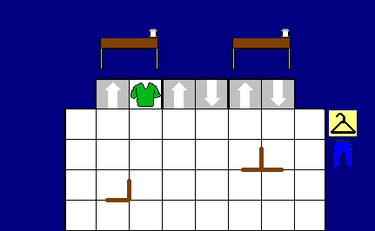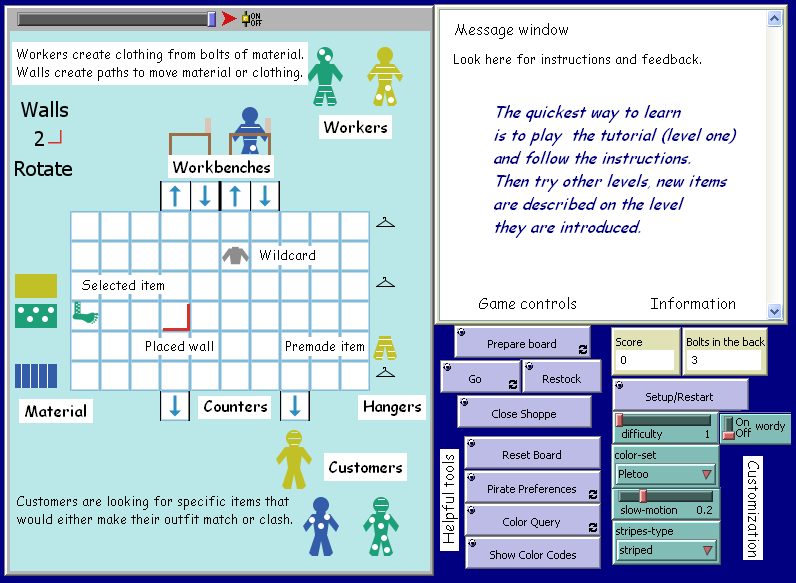GCPP:Proposal-Snook
Puzzle Codename: Snook
| Contact | |
| Username: | Patetch |
| Additional contact info: | Pletoo on Sage; pletoo@gmail.com |
| Project forum thread: | Forum
|
| A prototype is available for this proposal. | |
| Check it out and contribute to the design! |
Game concept
Starting with a bolt of cloth, send it to a worker who constructs an article of clothing. Then, using logic, match characteristics (color / pattern) to best complete a customer's outfit.
Objective
Efficiently run the shoppe, using the resources available and keeping the customers happy.
Gameplay
Quick overview of gameplay:
1. Decide which workers and customers you will use and place them at their appropriate stations.
2. Select any bolts of fabric or premade items you wish to move.
3. Use the walls to make paths to get them to their destinations.
4. Click go.
5. Repeat until you run out of bolts of material in the store-room. (The 'Closing Soon' message will appear.)
6. You may continue playing, as long as you have items to give the customers.
7. Click 'Close Shoppe' when you are ready to end the game.
You really will learn best by playing the tutorial.
Please refer to the notes section to learn about specific elements.
Please note: everything after this point is merely for reference and does not need to be read in order to play the game. Please play the level one tutorial first, then come back here if you have questions about a specific element of the game.
Scoring
Each turn
- +1 for every footprint when 'Go' is clicked (paths created)
- -1 for any worker placed at a bench without creating anything
- -5 for clicking 'Go' or 'Restock'
Walls cost points to place but also earn points every time they turn a path.
- L and I cost 1 point and earn 4 (so a gain of 3 points.)
- T, S, and Z cost 5 points and earn 7 (using only one corner gets 2 points but using both gets 9 total.)
- + costs 6 but earns 7 (using only one corner gets 1 point, using 2 corners gets 8, but using 3 gets 15.)
Customers
- Smiling customer: 20 * combo-counter ("Yay! I got what I wanted!")
- Neutral yellow customer: 10 points ("I got what I wanted but had to wait a bit.")
Red faced customers have penalties that scale with the difficulty level.
- Neutral red customer ("I didn't want this.") 1 1 2 3 5 6 7
- Frowning red ("I had to wait in line for THIS?!") 2 2 5 7 10 12 15
- Large frowning red (got mad and left without an item): 2 2 5 10 15 20 25
Misc
- -2 for every square crossed if a bolt is reshelved or clothing rehung.
- -5 if the space was occupied when reshelving bolts or hanging clothing (plus loss of item)
- +15 if bolt, spool, and uniform match or clash (does not include black.)
- + for cookies given to the workers (scaled by level and 'freshness.'
- - for wasted cookies
- Stepping on scissors, point first: -10
- Stepping on scissors, handle first: +10
- + for good destination
- - for bad destination
Closing shop
- -5 for each unshelved bolt of clot
- -5 for each item of clothing not on a hanger
- -5 for each bolt still in the storeroom (not on shelf yet) if the "Closing soon!" sign hasn't shown yet
- -5 for each customer who is red
- -5 for each customer at a counter
- -5 for any black clothing
- -5 for any black bolts on the shelf
Foot value: Start with 40 points. Deduct 2 point for each tile crossed, down to minimum of 5 points. If a "good destination" is reached, the value number of points is added to the score. If the foot came directly from a worker to a customer, a bonus of 20 points is added. If a "bad desination" is reached, the item being carried is lost, and the value of the foot is increased by 20, then is treated as a penalty (so subtract from score).
Combos can be scored with consecutive happy customers. The chain is broken when:
- Restock is clicked
- A turn without any customers served (on levels with 4 customers, 2 need to be served a turn.)
- A wasted or damaged item
- A 'bad destination' message is received
Variability
The combinations of material, pirates, and customers available are randomly generated, as well as the location of workbenches, counters, obstacles, wildcards, and special pieces on the board. The levels have different amounts of resources available.
If the game is too complex to start, the earliest levels could simply be making clothing (no customers.) Also, I have several ideas if it is not challenging enough at the high levels such as fads and mannequins (will be explained in detail if needed.)
End criteria
When the all of the bolts from the storeroom have been brought out to the shelf (depends on the level) then a "Closing Soon" message appears. The player can then play as long as there are items that can satisfy the customers and can click 'Close Shoppe" at any time.
Difficulty scaling
There are different amounts of material and people available depending on the level. Higher levels will have various obstacles to work around.
Crafting type
Tailor
Known problems
Some people feel that the game is too complicated, hopefully between the tutorial and tweaking of available items, this is not an issue anymore.
Notes
Color Codes
- red
- blue
- green
- light blue
- sky
- dark blue
- yellow
- teal
Control Panel
Please note: many of the controls here are a concession to the NetLogo prototype and the way it allows things to be done. Normally, the player would only have the 'Go' and 'Restock' buttons available (and probably the 'Close Shoppe.')
Message Window - here you will usually see things that affected your score. Game controls:
- Prepare board must be clicked at the beginning of each turn so that items may be picked up and moved on the playing field.
- Go is used to set the items in motion.
- Restock will provide a fresh supply of material and workers.
- Close shoppe ends the game, can be used at any time, but will receive a score penalty if used before the Closing soon message appears.
Helpful tools:
- Reset Board- Clears everything you have placed (walls, pirates, footprints.)
- Color Query- if you are uncertain of a color, you may click on this and then click on the object in question.
- Pirate preferences - click this button and then a worker or customer to see what they will make or buy.
- Show color codes - numbers the material, clothing, and customers for quick reference.
- Wordy - Use this to toggle the amount of feedback given (wordy comments on everything.)
Customization:
- Setup / Restart - set the options above to choose the game level, color set, and game speed you prefer.
Clothing
Bandanas, shirts, and pants are all made by the workers from the material. There are also premade items available on the hangers to the right. Clothing travels on the grid and should be sent to either a hanger or a counter. If it is sent to a counter without a customer, it will remain there until you place a customer to claim it. Likewise, clothing can remain at a workbench if a footprint was not set for it. If you wish to rearrange things, clothing can be moved to another hanger, any item that was there will be counted as wasted. In addition to the three main colors, clothing can also come in black which can be substituted for any color. Any clothing left on the board, except those on hangers, will be deducted from the final score when 'Close Shoppe' is clicked. Clothing can be damagaed if two objects collide while moving on the grid.
Color Sets
Here are the current color sets, created by (and named for) the testers that participated in the logical crafting event. The bold and the blue sets were two of the original ones.
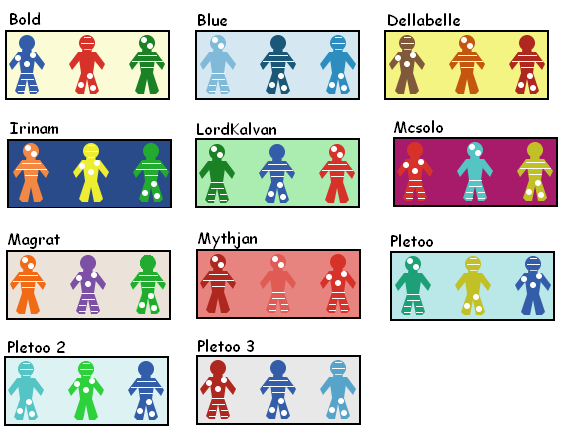
Combos
Combos are scored for consecutive happy customers. On levels with 4 customers, then 2 need to be served each turn, otherwise at least one a turn is needed. The combo chain is also reset when an item is damaged or wasted, when a customer is dissatisfied or upset, or when restock is used.
Cookies
Cookies are earned for scoring a triple and will stay on the board until they are used or the combo chain is reset. They have a different effect, depending on where they end up, leaving it up to the player to decide what is best.
- If they are picked up on the way to a workbench they give a bonus for making the workers happy.
- If they are picked up on the way to the hangers,(or any other bad location) they give a penalty for being messy (hanging up cookies just doesn't work!)
- If they are picked up on the way to a customer, that customer will walk away happy no matter what, and will not break a combo, however they will not build it either.
- If they are delivered to an empty counter, they will improve all the waiting customer's moods completely (does not affect a customer at the other counter.)
Counters
Counters are represented by the down arrows at the bottom of the grid. Customers should be placed here to pick up clothing. There are always 2 counters, at the end of each turn, one counter is moved to one of the other possible locations.
Customers
Customers start out in the lower right corner. Once you decide which ones you wish to use, place them at a counter. Each customer is looking for 3 items, any one of them would make them happy. Sometimes a color needs to be changed, sometimes it is the pattern, other times it is both.
To determine what a customer would like, first decide which trait is needing to be changed. Each trait needs to either match (all the same) or clash (all different.) There will be a specific instance of each article of clothing that would complete the outfit. (One would make the trait match, the other two would cause clashing.)
Customers are not known for their patience. Leave a customer in line too long and they will walk away upset, keep an eye out for customers showing their displeasure (indicated first by a yellow square then a red one.) Their mood drops every time 'Go' or 'Restock' is clicked and they are not served, but it can be improved slightly by placing them at a counter. Cookies can be used to make one customer perfectly happy or make all of them slightly happier. A customer that receives an item they don't like will walk away unhappy (unless they were also given cookies.) Any customer at a counter that is not served will be returned to the line.
Note There have been a couple comments about making the game less complicated by having the customers automatically placed at a counter or by having the ability to click a counter and have the first one in line get placed there. Having them wait in line was intentionally done so the player would have the opportunity to choose both which one(s) they would use each turn and where to place them, as well as a chance to plan ahead a little. If the majority of people feel that having this option is not worth the bother of having to pick up and place the customers, then we will certainly reconsider, though it is likely that such a change would push the game closer to luck than skill.
Customers (harder)
On higher levels, both traits need something changed. Possible correct outfit combinations:
- All same color; all same pattern
- All same color; all different patterns
- All different colors; all same pattern
- All different colors; all different patterns
First look at just the colors. He is wearing green, blue, blue. If you change the bandana to blue, then he will be all in blue. If you change either the shirt or the pants to aqua, then he will be wearing one of each color.
Now look at just the patterns. He is wearing spots, spots, stripes. If you change either his bandana or his shirt to solid, then he will have three different patterns. If you change the pants to spots, then he will be all in spots.
Now, putting them together, you get the following items:
- Solid blue bandana
- Solid aqua shirt
- Spotted aqua pants
Footprints
Footprints can be set by clicking on a bolt of material, workbench, or article of clothing. Clicking again removes the footprint. They take objects along the paths created with the walls. If an item was left at a workbench, it will receive a footprint when a new worker is placed there, a careful player will remember to create the path. It is possible to have a bolt of material arrive at the bench and be sent out as a completed item in the same turn by setting a footprint there. Try to get as much done in a turn as possible by setting multiple footprints.
Hangers
Hangers are on the right side of the board. Sometimes a premade item will be there as well. Clothing that cannot be used immediately may be placed on a hanger for storage. At the end of the game, unused clothing should be placed on hangers to avoid a penalty when 'Close Shoppe' is clicked. Items can be moved from one hanger to another, but if something was already in that location it is counted as lost.
Material
Material comes in 3 colors and 3 patterns (solid, stripes, polka-dots.) It starts on the left side of the board, and should be sent to a workbench. It can also be reshelved anywhere along the left wall (sometimes it is nice to move a bottom bolt up if you know you will be using it next turn.) If the new location is occupied, the original bolt will be counted as wasted, and will be replaced by the new one. Bolts of material are used to pick up the wildcards from the grid. A bolt that runs over a black one will be replaced. If one is sent to a workbench without a worker, it will wait until one is placed there. If a point is reached where none of the bolts are useful, you may click 'Restock' to get a fresh batch, be warned though that customer's moods will drop, and it will break a combo chain. On each level, there is a set number available (you can check the 'Bolts in back' readout on the control panel) when the last bolt has been placed on the shelf, the "Closing Soon" message will appear, the player can then click 'Close Shoppe' without a penalty.
Obstacles
There are two types of obstacles that can appear on the grid. Both will be randomly placed each turn. Objects that run into these will be bounced back the way the way they came. Obstacles can be used as a corner if they happen to form one. The first type is a single wall. Every time go or restock is clicked a new one will show up on the board. The second type is a block that shows up any time a customer leaves with a red face, or when 'Restock' is clicked.
Paths
Paths are created on the grid by placing walls or strategically using preplaced obstacles. Any object that has been given a footprint will travel in a straight line until they are turned by a corner, reach their destination, or are bounced back by hitting a straight wall or the back side of an 'L.' If a path leads an object to a bad destination (ie: material sent to a hanger) there will be a penalty and the item is lost. Send items on the shortest path you can. Items travel at the same rate, be careful not to let them collide at an intersection.
Scissors
Scissors sometimes apeear instead of one or more straight walls when the board is replenished after clicking 'Go.' A path that approaches them from the handle side will receive a bonus, however paths that run into the blades will receive a penalty.
Spool of thread
Thread sits on the workbenches and is changed to the color of the material that was last used at the bench. A player can receive a bonus if the spool, new worker, and new bolt either match or clash (black does not earn a bonus.) If the bench is not used to make something, then the spool will reset.
Walls
Use the walls to create paths for the items to travel on. They can be picked up, rotated, and moved as many times as necessary until you are satisfied. If a wall is placed near an obstacle in such a way that it forms multiple corners, they can be used to form several paths. There is a slight penalty for each wall used but it is balanced out by earning points when a path hits it. On the higher levels, extra wall shapes are available in limited quantities. These walls earn extra points and can often be used to form multiple paths. Use 'Reset Board' to clear these. Walls cost points to place but they also earn points every time they turn a path, use the best one for the job to score the most points.
Workbenches
Workbenches have an up arrow for bolts of material and a down arrow for the finished product. Material that is sent to a bench without a worker will stay there until a worker is placed. Likewise a newly created item will stay at the bench unless a footprint has been set there. If an item was left at the bench, a footprint will automatically be set when a worker is placed there. There are always two benches available, one will move to a new location every time the board is refreshed after 'go' is clicked. Workers at the bench will leave after one turn whether they have made something or not, so choose wisely. The benches do not need to all be filled every time, productivity is good, but be careful - if the hangers get too full, you will have to either give a customer an item they don't want, or lose one item by placing another one on the same hanger (both of which resets a combo chain.)
Workers
Note There have been a couple comments about making the game less complicated by having the workers automatically placed at a workbench. Having them wait in line was intentionally done so the player would have the opportunity to choose both which one(s) they would use each turn and where to place them, as well as a chance to plan ahead a little. If the majority of people feel that having this option is not worth the bother of having to pick up and place the workers, then we will certainly reconsider, though it is likely that such a change would push the game closer to luck than skill.
Wildcards
There are six wildcards, one will always be randomly placed on the board, and can be picked up by a bolt of material crossing over it. Sewing patterns (bandana, shirt, and pants) will cause a worker to make the item depicted rather than match the pattern on the material to their uniforms. Black bolts of material come in all three patterns and will replace a bolt that runs over it. Clothing will still be made according to the pattern but black can be substituted for any color.
Images
The images from the NetLogo prototype by Tcarr
Some images and examples from previous versions of this proposal:
